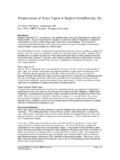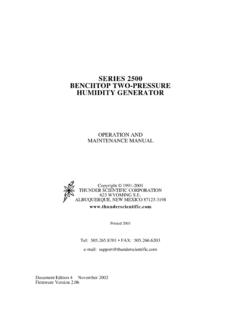Transcription of Determination of Relative Humidity in Subzero …
1 Copyright 1998 RH Systems, All Rights ReservedPage 1 of 5 Determination of Relative Humidity in Subzero TemperaturesBob HardyRH Systems, Albuquerque, New Mexico, USAA bstract: Relative Humidity of a gas, at any given temperature, is defined as thepercentage ratio of the amount of water vapor present in the gas to the maximum amountof water vapor possible at that same temperature. At temperatures above freezing, watercan exist in only one of two thermodynamically stable states. It can exist in the gaseousform, known as water vapor, or it can condense into a liquid, often referred to as as might be expected at Subzero temperatures , water can exist as either a gas, againknown as water vapor, or it can condense in the form of a solid, often referred to as eitherfrost or ice. But contrary to intuition, water at Subzero temperature can also exist in athird thermodynamic state, liquid. The Subzero liquid state is an achievable metastablestate with an energy level between that of the gas and solid.
2 Subzero water in thismetastable state is said to be super-cooled. It is most often referred to as super-cooledwater, super-cooled dew, or super-cooled liquid, all of which mean the same in the super-cooled state is a liquid, but is at a Subzero (below freezing)temperature. In the temperature range 0 to 40 C, the super-cooling phenomenon is quiteprevalent. At these Subzero temperatures , where the possibility of super-cooling exists, Relative Humidity may be computed in either of two distinct methods, termed Standardand RH: Mathematically, the formula for calculation of Relative Humidity isexpressed as%RH = e / es * 100(1)wheree is the water vapor content of the gas (water vapor pressure)es is the maximum possible water vapor content of the gas at that sametemperature (saturation vapor pressure)As expressed in the above formula, only two things must be known (namely e and es) inorder to determine the Relative Humidity .
3 The saturation vapor pressure, es, which is an expression of the maximum possible watervapor content at the gas temperature, is a well-known quantity. Saturation vapor pressureis determined by measuring the gas temperature, then computing the correspondingsaturation vapor pressure using documented saturation vapor pressure formulas1. Theseformulas express vapor pressure as a function of temperature. Note that there is aformula for saturation vapor pressure over water for temperatures above freezing, andone over ice for Subzero 1998 RH Systems, All Rights ReservedPage 2 of 5 The actual water vapor content (or water vapor pressure) is often determined throughmeasurement. One popular measurement method is chilled mirror hygrometry. Throughmeasurement of either the frost point or dew point from the chilled mirror hygrometer,the actual vapor pressure is determined from the same saturation vapor pressureformulas1 as above.
4 When doing so, the formula for saturation vapor pressure over wateris used for dew point temperatures , while frost points require the saturation vaporpressure over ice. Not that regardless which measurement is obtained from the chilledmirror (dew or frost point), the corresponding vapor pressure will be the for Standard RH, the denominator of equation 1 (the maximum possible water vaporcontent) is computed over water for temperatures above freezing, and over ice for allbelow freezing temperatures . In a two-temperature Humidity generator, where thesaturator is condensing/subliming to/from ice, this is the proper representation of themaximum possible water vapor content. Likewise, the numerator (the actual water vapor content) is computed over water whenthe mirror measures a dew point, and over ice for all frost point measurements. In thisway, Standard RH values are achievable up to 100% both for warmer, and subzerotemperatures.
5 Standard RH assumes that the maximum water vapor content possible isthrough saturation over ice for Subzero temperatures . WMO RH: WMO RH computations, and the following discussion, apply only totemperatures below freezing. In the atmosphere, it is possible to have condensation ofvapor into the liquid (rather than ice) state at temperatures below freezing through thephenomenon known as super-cooling. In fact, most chilled mirrors exhibit this super-cooled state at temperatures between 0 and about 20 C. Whether the measurementindicates it is super-cooled or not, is completely independent of any methods used tosaturate or otherwise impart water vapor into the gas, or any methods used to removewater vapor from the gas. Super-cooled condensation on a mirror (a dew pointmeasurement) is a perfectly allowable metastable state, just as condensation on the mirrorto ice (a frost point measurement) would be a perfectly allowable stable state.
6 However,the super-cooled dew will occur at a temperature below that of the ice, and results in thesame measure of water vapor content. Since the super-cooling phenomenon does occur in clouds and the upper atmosphere, itwas decided nearly a half century ago by the World Meteorological Organization (WMO)that RH be calculated by computing the denominator (or maximum possible water vaporcontent) over water rather than ice regardless of the temperature. This results in a highervalue of maximum possible water vapor content at any given temperature, than does thecorresponding computation over ice at the same temperature. It appears that the basisbehind the decision was to prevent the occasional possibility of RH values in excess of100% when the atmosphere was in a super-cooled state. In this state, an atmospheresaturated with respect to super-cooled water is considered over saturated with respect toice. An RH of 100% calculated with the WMO method would actually be >100% ifCopyright 1998 RH Systems, All Rights ReservedPage 3 of 5computed as Standard RH.
7 It is also important to note that with both methods, the actualwater vapor content is equal and identical. It is only the maximum possible vapor contentthat is different which is dependent upon whether the atmosphere is in a super-cooledmetastable state or vs. WMO Computations: The Standard and WMO methods of RH computationwill produce different numeric results, given the same actual water vapor content (e), andthe same temperature. The following tables illustrate the differences at varioustemperatures, first at 100% RHWMO, and then again at 100% RHStandard:t CRHWMORHS tandard0100%100%-10100% CRHWMORHS tandard0100%100% , the only difference between the WMO and Standard methods is whether thedenominator of the RH equation is calculated with respect to water or with respect to the Standard method, it is assumed that water vapor in excess of the maximumpossible will condense out in the form of ice. With the WMO method, it is assumed thatthe water vapor can be over saturated with respect to ice, and any water vapor in excessof the maximum possible with respect to super-cooled water will condense out in theform of super-cooled also that in the case of 100% RHWMO, there is a significant amount of oversaturation with respect to ice.
8 If ice does begin to form somewhere, the effect will be fora significant amount of icing to occur in that area as the gas attempts to reduce its actualwater vapor content to 100% RHStandard. Take the case in the above table of 40 C with 100% RHWMO. Since the RHStandard is148%, if icing does begin to occur somewhere, the excess 48% will be attempting tocondense into additional ice buildup in order to drive the actual water vapor content downtoward 67% RHWMO or 100% 1998 RH Systems, All Rights ReservedPage 4 of 5 Humidity Generation: When generating RH from an ice filled saturator, or from onewhich condenses to ice, the maximum possible water vapor content obtainable is withrespect to ice at the saturation temperature, provided the gas undergoes no further coolingafter leaving the saturator. Also, in a gas stream saturated to 100%RH with this method,condensation should not occur on any object who s temperature is even slightly warmerthan the saturation temperature (also equivalent to the measured frost point temperaturewhen the gas is saturated to 100%RH).
9 The following graph illustrates the maximum obtainable RH assuming that the humidityis generated using two-temperature techniques in an ice saturator, and that there is nofurther cooling of the Achievable RHUsing an Ice Saturator020406080100120-40 -30 -20 -10010 20 Temperature C%RHRHwmoRHstdCopyright 1998 RH Systems, All Rights ReservedPage 5 of 5If the Humidity can be generated in such a way as to provide full saturation with respectto super-cooled water (over saturation with respect to ice) without causing ice or frostformation, then the following graph illustrates the maximum achievable RH. Note thatany formation of ice will attempt to limit the maximum to the equivalent of 100% Achievable RHUnder Super-Cooled Conditions020406080100120140160-40 -30 -20 -10010 20 Temperature C%RHRHwmoRHstdNote that in each of the graphs above, RHStandard and RHWMO, at a given temperature,represent the exact same water vapor content in the gas.
10 The only reason the RH valuesdiffer from each other in value is that the denominator of the equation (the maximumpossible water vapor content) is :1. Hardy, Bob, ITS-90 Formulations for Vapor Pressure, Frostpoint Temperature,Dewpoint Temperature, and Enhancement Factors in the Range 100 to +100 C,Papers and Abstracts from the Third International Symposium on Humidity &Moisture, London, England, April 1998, Volume 1, 214-222.


